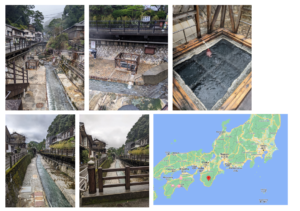I’ve talked quite a bit in these posts about Japanese hot springs (Wow Places #28, #61 and #159), which I absolutely love. One of the most unusual I’ve experienced, Yunomine Onsen, enjoys a prominent position on the famous Kumano Kodo pilgrimage route (Wow Place #25). Located near Hongo Town in southern Wakayama Prefecture, Yunomine is a scenic little burg with a hot creek running straight through the center of town. Here’s what makes it interesting:
First, it’s got a UNESCO World Heritage bath, Tsoboyu. You heard that right. The gentle folks at UNESCO deemed that, along with more imposing structures like the Taj Mahal and the Great Wall of China, a bath in the middle of rural Japan should hold the similar title of World Heritage site! Sounds impressive, huh? In reality, the bath is essentially a shack on top of the creek, holding at most 1 to 2 people. You wait in line, enter the shack, plop down into a little puddle formed by a circle of rocks, and get yourself healthy. Legend has it that the waters of Tsuboyu have miraculous healing properties, the result of a spring found flowing out of a stone statue of Yakushi Nyorai, the Buddha of healing and medicine.

Second, Yunomine has a public spring, Yuzutsu, that is used as a community cooking basin. For a nominal fee, you can buy special hot spring eggs (onsen tamago) and/or local vegetables and cook them in the spring. My own favorite onsen treat is boiled sweet potatoes. Apparently some of the traditional guest houses (ryokans) in the area use the hot spring water to cook rice porridge – hopefully not from the World Heritage bath! As for most things in Japan, this is a very old tradition. People have been cooking food in the springs since at least the Edo Period (1603-1868), plopping their food items into a net and cooking them in the 194F degree water. The locals, it seems, claim that vegetables cooked in the spring water lose their bitter flavor, and meat is tenderized as well.
I can certainly attest that my sore muscles were tenderized while in Yunomine. After a long, 7-hour day of hiking the Kumano Kodo, Donica and I greatly enjoyed our soak in this quaint, historical hot spring town. We particularly enjoyed the private outdoor bath offered by the J-Hoppers guest house, essentially a youth hostel – with hot springs. Would I make a special trip to Wakayama prefecture just to visit the World Heritage site of Yunomine hot springs? Probably not. But if you’re in the area, doing the pilgrimage, stop on by the springs—and don’t forget your eggs and vegetables.
(Not everything in life has to be a “peak experience.” Sometimes the more subtle moments are the ones you enjoy the most and remember the longest. We can get caught up in checking off our bucket lists adrenalized experiences like sky diving and hang gliding. But why not take a breath, slow down and appreciate the small pleasures – like soaking in a rural hot spring bath? Or boiling an egg?)
